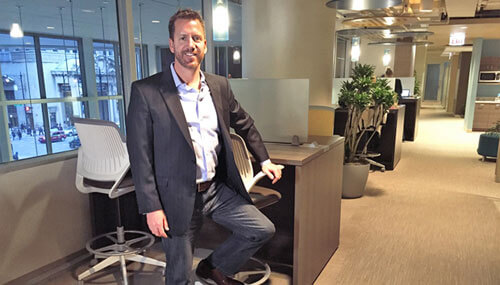Entrepreneur Insight
Telecommuting is Overrated: Demand for Office Space Rising

Turns out work is best done face-to-face, fueling a commercial real estate resurgence.
Telecommuting was supposed to be the final nail in the coffin for water-cooler gossip at the office.
With technological advances like Skype-fueled video conference calls, ubiquitous email, and 24/7/365 access to your boss via smartphones, it seemed like every U.S. employee would, sooner rather than later, work from home rather than commute to a job in an office complex.
Think again.
From Marissa Mayer's directive that all staff must report to an office, to the edgy concept of “hot desking” that obliterates the concept of assigned seating, the new trend in employee staffing is to bring everyone together, face-to-face, inside an office building.
Maybe the concept of telecommuting should be tossed into the dustbin, along with all-robot assembly lines and flying cars as a replacement for vehicles that travel on four wheels.
This Job Isn't Obsolete
Christopher Rogala, president at the brokerage firm Office Space Chicago Inc., said friends used to joke with him that his job was becoming obsolete, as everyone seemed to be working from home.
“People used to kid me I was going to lose my job,” Rogala said. “But people are really into collaboration right now. They find it's better and more productive to do it face-to-face.”
Rogala's buddies aren't making those jokes anymore. Recent data shows the reasons why.
The rate of available class A office space has steadily declined during the past five years, according to Keith DeCoster, director of U.S. real estate analytics at Savills Studley Inc. The nationwide availability rate in the fourth quarter of 2010 was 19.3 percent; by the end of the fourth quarter in 2015, the most recent data available, that rate had dipped to 18.1 percent.
Available space is dwindling as employers are rushing to lease as much space as they can get their hands on. Employers added 15.3 million square feet of office space in the fourth quarter, according to Reis Inc., a New York real estate data firm. That's the most space added since the third quarter of 2007.

" People are really into collaboration right now. They find it's better and more productive to do it face-to-face."
Keyword: Collaboration
Employers are using a common buzzword to explain the urgency to add more space to hold their workers: collaboration. After years of thinking that employees would be more productive if they didn't spend so much time traveling back and forth between home and office, they're now singing a different tune. It appears something was lost in the shift to telecommuting: the value of in-person interaction among colleagues.
“It's key to productivity and morale,” DeCoster said. “If you have people working remotely, how do you build that synergy?”
Technology companies, perhaps somewhat ironically, are leading the way. Although it would seem high-tech firms might already be using the best tools for videoconferencing and other forms of communication, technology developers instead have been at the forefront of understanding the inherent value of employees sitting together in the same office.
It's not limited to geography, either. Not only are Silicon Valley, Seattle and Boston companies moving back to office-based work, employers in more interior parts of the nation are also getting in on the act. The Abbi Agency, a marketing and public relations firm in Reno, Nev., just added an extra 4,000 square feet of office space simply to secure the square footage in case of future expansion.
“Rates are going up quickly here because companies like Tesla and Switch [a data center operator] are moving here,” said Abbi Whitaker, a co-founder of the agency. “All of a sudden, Reno is on everyone's radar.”
There are more tangible reasons for having employees work in an office, DeCoster said. It's much easier to conduct training if your employees are located at an office. Then there is the importance of recruiting members of the Millennial Generation, who “want to be in an urban area,” he said.
'A Modern-Day Company Town'
State Farm Mutual Automobile Insurance Co. is the perfect example. A heartland company headquartered in Bloomington, Ill., State Farm is a leader in an old-line industry sector – insurance. It was founded in 1922, and it needs to recruit younger employees.
So State Farm is building two huge new office complexes -- one in Dallas and one in Atlanta. The Atlanta location, totaling about 602,000 square feet of office space, is situated next to one of the city's rapid-transit rail lines and is in the middle of a busy commercial district.
The Dallas-area site was designed specifically with recruiting in mind, according to State Farm's developer, KDC. It boasts 1.5 million square feet of space and includes residential, hospitality and medical uses, in addition to office space.
“The insurance giant wanted to essentially create a modern-day company town,” KDC said in a sales description of the project. “It’s becoming clear that work environment is almost as important to attracting and retaining top employees as pay and benefits.”
Plenty of large employers are doing the same thing as State Farm, including Charles Schwab Corp. and Liberty Mutual Insurance, as well as Toyota Motor Corp., which is moving its U.S. headquarters to a larger space, according to DeCoster.
Boon for Landlords
Thus, it's not just tech companies that are bringing workers back into the office, Rogala said.
“I'm seeing it from tech firms, real estate brokers and financial advisers,” Rogala said. “Retail companies are also adding more office space for their headquarters.”
All this seems to be good news for landlords, too. If more and more companies want to increase their numbers of work-at-work employees, they'll need more space. Higher demand means landlords that own office buildings can charge more for rent, and it also means they're less likely to be sitting on vacant buildings.
Indeed, the largest markets have seen an increase in how much landlords charge to lease space. Asking rents in Boston increased 2.9 percent from the second quarter to the third quarter of 2015, according to the most recent data available from Savills Studley. New York asking rents rose 2.6 percent and those in San Francisco rose 2.5 percent.
Even with higher prices, some office markets are so hot that “the developer doesn't even have to market the space,” DeCoster said.
Some Still Working from Home
Not everyone thinks it's a great idea to ban the practice of working from home. Employers need to be flexible and allow work-life balance, according to Results-Only LLC, a workplace consulting firm in Minneapolis. Instead of emphasizing how many hours of face time you put in at the office, it's better to stress an employee's results.
The Garabedian Group, an accounting firm in Fresno, Calif., that's a Results-Only client, wanted to create an environment that de-emphasizes the concept of “presenteeism,” the idea of being physically present but not actually working, said Aaron Garabedian, a business adviser with the firm.
Instead of having everyone locked in a game of who can put in the most face time at work, The Garabedian Group wanted to stress expectations and results, he said. That can include having its employees work from home.
Hot Desking
While plenty of employees may continue to work from home, it also appears that there's at least a small backlash going on. The concept of hot desking might be the ultimate lure for young workers who seek an egalitarian, collaborative workspace. “Hot desking” means no one has his or her own assigned desk; instead, anyone can drop down at any desk and call it their own, for a short or a long period of time.
So much for assigned seating, eh?
Rogala said that, at Office Space, the spaces his clients have offer limited amounts of privacy, along the lines of what a hot-desking office looks like. Landlords have had to make some concessions in that regard, however, such as adding small rooms for breakout sessions.
“When these open floor plans started happening, you would see people out in the hallway on their cell phones,” he said.
But it seems that Mayer, Yahoo's CEO, may have launched an office revolution of sorts in February 2013. Her call for Yahoo's employees to work from an office was based on the idea that being side by side improves work “speed and quality,” a company spokeswoman said at the time.
“A lot of this is a creative process, where employers are trying to come up with new and innovative ideas,” Rogala said. “As opposed to having an employee sitting on their couch with a laptop, people getting together seems to be where companies are at right now.”
Sign up for the Reach Further Newsletter
We’ll keep you in the know about the latest US-Asia business news and trends.
Suscríbase al boletín Reach Further
Lo mantendremos informado sobre las últimas noticias y tendencias comerciales entre Estados Unidos y China.

